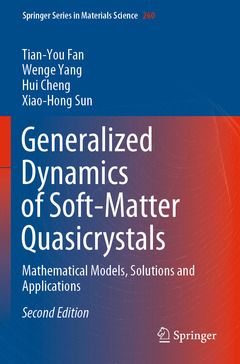Notations
Preface to the first edition
Preface to the second Edition
Chapter 1 Introduction to soft matter
Chapter 2 Discovery of soft-matter quasicrystals and their properties
2.1 Experimental observation of quasicrystalline phases in soft matter
2.2 Characters of soft-matter quasicrystals
2.3 Some concepts concerning possible generalized dynamics on soft-matter quasicrystals
2.4 First and second kinds of two-dimensional quasicrystals
2.5 Motivation of our discussion in the book
Chapter 3 Brief review on elasticity and hydrodynamics of solid quasicrystals
3.1 Introduction of the elasticity of quasicrystals, phonon and phason
3.2 Deformation tensor: strain and stress tensors
3.3 Equations of motion
3.4 Free energy density and elastic constants
3.5 Generalized Hooke’s law
3.6 Boundary conditions and initial conditions
3.7 Solutions of elasticity
3.8 Hydrodynamics of solid quasicrystals
3.9 Solution of hydrodynamics of solid quasicrystals
3.10 Summary
Chapter 4 Case study of equation of state of several structured fluids
4.1 Overview on equation of state in some structured fluids
4.2 Possible equations of state
4.3 Application to dynamics of soft-matter quasicrystals
4.4 The incompressible model of soft matter
Chapter 5 Poisson bracket method and equations of motion of soft-matter quasicrystals
5.1 Brownian motion and Langevin equation
5.2 Extended version of Langevin equation
5.3 Multivariable Langevin equation, coarse graining
5.4 Poisson brackets in condensed matter physics
5.5 Poisson brackets application to quasicrystals
5.6 Equations of motion of soft-matter quasicrystals
5.7 Poisson brackets based on Lie algebra
5.8 On solving governing equations
Chapter 6 Oseen theory and Oseen solution
6.1 Navier-Stokes equations
6.2 Stokes approximation
6.3 Stokes paradox
6.4 Oseen modification
6.5 Oseen steady solution of flow of incompressible fluid past cylinder
6.6 The reference meaning of Oseen theory and Oseen solution to the study in soft matter
Chapter 7 Dynamics of soft-matter quasicrystals with 12-fold symmetry
7.1 Two-dimensional governing equations of soft-matter quasicrystals of 12-fold symmetry
7.2 Simplification of equations
7.3 Dislocation and solution
7.4 Oseen modification
7.5 Steady dynamic equations under Oseen modification in polar coordinate system
7.6 Flow past a circular cylinder
7.7 Three-dimensional equations of generalized dynamics of soft-matter quasicrystals with 12-fold symmetry
7.8 Governing equations of generalized dynamics of incompressible soft-matter quasicrystals of 12-fold symmetry
7.9 Conclusion and discussion
Chapter 8 Dynamics of 10-fold symmetrical soft-matter quasicrystals
8.1 Statement on soft-matter quasicrystals of 10-fold symmetry
8.2 Two-dimensional basic equations of soft-matter quasicrystals of point groups
8.3Dislocation and elastic displacement field
8.4 Probe on modification of dislocation solution by considering fluid effect
8.5 Transient dynamic analysis
8.6 Three-dimensional equations of soft-matter quasicrystals of point groups
8.7 Incompressible complex fluid model of soft-matter quasicrystals with 10-fold symmetry
8.8 Conclusion and discussion
Chapter 9 Dynamics of possible soft-matter quasicrystals with 8-fold symmetry
9.1 Dynamic equations of quasicrystals with 8-fold symmetry
9.2 Dislocation and elastic displacement field
9.3 Transient dynamic analysis
9.4 Flow past a circular cylinder
9.5 Three-dimensional equations
9.6 Incompressible model of soft-matter quasicrystals with 8-fold symmetry
9.7 Solution example of incompressible model
9.8 Conclusion and discussion
Chapter 10 Dynamics of soft-matter quasicrystals with 18-fold symmetry
10.1 Six-dimensional embedded space
10.2 Elasticity of possible solid quasicrystals with 18-fold symmetry
10.3 Dynamics of soft-matter quasicrystals of 18-fold symmetry with point group
10.4 Static case of first and second phason fields
10.5 Dislocation and elastic displacement field
10.6 Discussion on transient dynamics analysis
10.7 Three-dimensional equations of generalized dynamics of soft matter quasicrystals of 18-fold symmetry with point group
10.8 Incompressible complex fluid model of soft-matter quasicrystals of 18-fold symmetry
10.9 Conclusion and discussion
Chapter 11 Dynamics of possible soft-matter quasicrystals with 7-, 9- and 14-fold symmetries
11.1 The possible 7- fold symmetry quasicrystals with point group of soft matter and the dynamic theory
11.2 The possible 9- fold symmetrical quasicrystals with point group of soft matter and their dynamics
11.3 Dislocation solution of 9-fold symmetry quasicrystals
11.4 The possible 14- fold symmetrical quasicrystals with point group of soft matter and their dynamics
11.5 The numerical solution of dynamics of 14-fold symmetrical quasicrystals of soft matter
11.6 Incompressible complex fluid model
11.7 Conclusion and discussion
Chapter 12 Re-discussion on symmetry breaking and elementary excitations concerning quasicrystals
Chapter 13 An application to thermodynamic stability of soft-matter quasicrystals
13.1 Introduction
13.2 Extended free energy of the quasicrystal system in soft matter
13.3 The positive definite nature of the rigidity matrix and the stability of the soft-matter quasicrystals with 12-fold symmetry
13.4 Comparison and examination
13.5 The stability of 8-fold symmetry soft-matter quasicrystals
13.6 The stability of 10-fold symmetry soft-matter quasicrystals
13.7 The stability of the 18-fold symmetry soft-matter quasicrystals
13.8 Conclusion
Chapter 14 Applications to device physics---photon band-gap of holographic photonic quasicrystals
14.1 Introduction
14.2 The design and formation of holographic quasicrystals
14.3 Band-gap of 8-fold quasicrystals
14.4 Band-gap of multi-fold complex quasicrystals
14.5 Fabrication of 10-fold holographic quasicrystals
14.6 Band-gap of choleteric liquid crystals
14.7 Conclusions
Chapter 15 Possible applications to general soft matter
15.1 A basis of dynamics of two-dimensional soft matter
15.2 The outline on governing equations of dynamics of soft matter
15.3 The modification and supplement to equations (15.2.1)
15.4 Solving for the dynamics of soft matter
15.5 Conclusion and discussion
Chapter 16 Applications to smectic-A liquid crystals, dislocation and crack
16.1 Basic equations
16.2 The Kleman-Pershan solution of screw dislocation
16.3 Common fundamentals of discussion
16.4 The simplest and most direct solving method and additional boundary condition
16.5 The mathematical mistakes in the classical solution
16.6 The physical mistakes in the classical solution
16.7 Properties of the present solution
16.8 Solution on plastic crack
Chapter 17 Conclusion remarks




